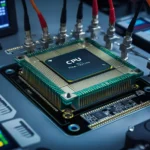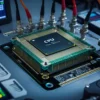Computer systems have seen an extraordinary evolution that mirrors the rapid pace of technological advancement. From the monumental machines of the mid-20th century to today’s sophisticated quantum computers, the journey of computing power is a tale of innovation, transformation, and profound implications for society. This comprehensive exploration delves into the historical milestones, technical innovations, and future outlook of computer systems, providing insights into how far we’ve come and where we might be headed.
Historical Context: The Birth of Computer Systems
The Mainframe Era
The story of computer systems begins in the 1950s with the advent of mainframe computers. Machines such as the IBM 701 and UNIVAC I were huge, occupying entire rooms and requiring teams of engineers to operate. These early mainframes were primarily utilized by large corporations and government agencies for complex calculations essential for scientific research, data processing, and business operations.
These computers used vacuum tubes and later transistors, which marked the beginning of semiconductor technology. Mainframes became synonymous with reliability, security, and high processing power. They offered batch processing capabilities and could handle hundreds of tasks simultaneously, albeit with poor user interactivity. It was a time when computational resources were scarce, and access was often limited to large establishments.
The Advent of Microprocessors and Personal Computers
The next significant shift came in the 1970s with the invention of the microprocessor. Intel’s 4004, introduced in 1971, was the world’s first commercially available microprocessor, enabling the development of personal computers (PCs). The Apple II, produced in 1977, democratized computing, bringing the power of computation into homes and small businesses.
The 1980s witnessed an explosion of personal computing, with manufacturers like IBM and Apple leading the charge. The introduction of graphical user interfaces (GUIs), driven by innovations like the Macintosh system, transformed how users interacted with computers. Users were no longer confined to text commands; they could use visual icons to navigate and operate their machines, significantly lowering the barrier to entry.
The Rise of Networking and the Internet
The development of networking and the eventual rise of the internet in the 1990s represented a monumental leap in computer technology. Initially designed to facilitate information exchange among researchers, the internet became the backbone for global communication and commerce. Businesses recognized the value of interconnectivity, leading to the birth of client-server architectures that enabled resource sharing and better user experiences.
Technologies such as TCP/IP protocols allowed diverse systems to communicate, facilitating the growth of web-based applications. The introduction of databases enabled the efficient storage and retrieval of vast amounts of data, paving the way for enterprises to leverage information to drive decision-making.
Technical Innovations and Industry Insights
Distributed Computing and Cloud Technology
As systems became more powerful, software development also evolved. The shift towards distributed computing architectures in the 2000s allowed workloads to be spread across multiple machines, significantly enhancing processing capabilities. The emergence of cloud computing further revolutionized the industry. Providers like Amazon Web Services (AWS), Microsoft Azure, and Google Cloud Platform made compute resources virtually limitless, allowing businesses to scale their operations without heavy capital investments in physical infrastructure.
Cloud technologies have shifted how applications are built, deployed, and maintained. This decentralized model offers flexibility and efficiency, enabling organizations to adapt quickly to changing needs. The rise of virtualization technologies, such as VMware and hypervisors, further facilitated resource allocation and management, allowing multiple virtual machines to run on a single physical server.
The Era of Mobile Computing
Simultaneously, the proliferation of mobile computing introduced another dimension to computer systems. The introduction of smartphones in the late 2000s, starting with Apple’s iPhone, created new paradigms for interaction and accessibility. Mobile applications quickly became integral to daily life, requiring developers to innovate quickly and frequently with updates and improvements.
Mobile systems ushered in a wave of new technologies. Touchscreens, voice recognition, and biometric authentication became prevalent features, enhancing user experience. The integration of location-based services and sensors expanded the utility of mobile devices beyond communication, turning them into versatile tools for navigation, health monitoring, and more.
The Age of Artificial Intelligence and Machine Learning
In the last decade, the sheer volume of data generated globally has propelled advancements in artificial intelligence (AI) and machine learning (ML). Technologies that harness these capabilities have profoundly changed how computer systems function. From deep learning algorithms enabling image and speech recognition to natural language processing models driving virtual assistants, AI represents a transformative wave that integrates cognitive capabilities into computer systems.
Big data analytics has become a cornerstone for businesses, allowing them to derive insights from large datasets. Companies leverage AI to automate operations, enhance customer experiences, and make data-driven decisions. Understanding user behavior through analytics helps organizations optimize products and services.
The Quantum Leap: Quantum Computing
A New Paradigm
While classical computers encode information in bits (0s and 1s), quantum computers leverage the principles of quantum mechanics to use qubits, which can represent and store information in multiple states simultaneously. This creates a new computational paradigm offering unprecedented processing power. Companies like Google, IBM, and D-Wave are at the forefront of this technology, exploring applications ranging from cryptography to complex optimization problems.
Quantum computers are not designed to replace classical computers but to complement them for specific tasks. Problems that are currently intractable for classical computers, such as simulating molecular interactions in drug discovery or solving complex optimization challenges, could be transformed by quantum processing capabilities.
Industry Insights and Innovations
The race towards practical quantum computing has generated significant interest and investment. Initiatives such as the Quantum Internet, a network of quantum computers capable of sharing qubits, have gained traction, promising to revolutionize secure communication. Additionally, organizations are developing hybrid models that integrate quantum capabilities with classical systems, enhancing the performance of computational tasks.
The growing interest in quantum technologies has led to an increasing pool of talent in the field. Academic institutions are ramping up programs to educate the next wave of researchers and engineers, ensuring that the industry is well-equipped to harness the potential of quantum computing.
Future Outlook: The Next Frontier
Emerging Technologies
As we look ahead, the future of computer systems appears promising, with exciting developments on the horizon. As classical computing continues to improve through advancements in materials science and chip architecture, we can expect faster, more efficient hardware.
Furthermore, the integration of sophisticated AI systems into computer architectures will lead to smarter machines capable of self-learning and adaptation. Technologies such as edge computing are expected to gain prominence, allowing processing to occur closer to data sources rather than relying on distant cloud servers.
The Ethical Dimension
With the rapid evolution of computer systems, ethical considerations have gained importance. Concerns about privacy, data security, and the potential misuse of AI underscore the need for regulations and ethical standards in technology development. Organizations must prioritize responsible AI practices, data governance, and transparency to build trust with users and stakeholders.
The Ongoing Evolution
In sum, the evolution of computer systems from mainframes to quantum computing illustrates the relentless march of progress. Each leap in technology has built upon the last, leading to a world where computation is ubiquitous in personal, professional, and societal realms. The interplay between hardware innovations, software development, and connectivity continues to create new paradigms in which computers enhance human capabilities and transcend traditional limits.
Conclusion
The evolution of computer systems is not merely a narrative of technological advancement; it reflects the collective human endeavor to augment our capabilities and solve complex problems. As we stand on the brink of a quantum future, the possibilities seem limitless, yet the challenges are equally formidable. It is crucial to harness these technologies responsibly, ensuring they serve the greater good while minimizing risks.
Continued investments in education, research, and ethical practices will shape the trajectory of computing for years to come. The landscape may change, but at the heart of this evolution remains a commitment to innovation and the aspiration to create a better, more connected world. With each stride forward, we are not just redefining what computers can do; we are reshaping the very fabric of our society.


















